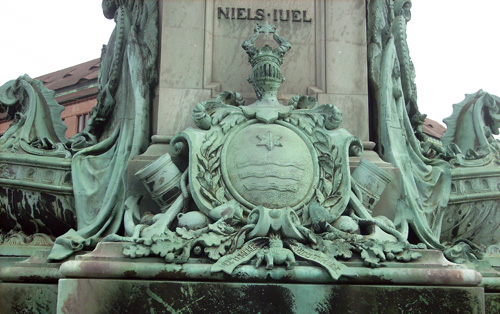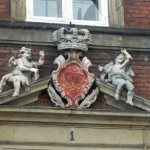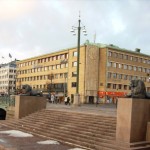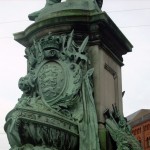A shield azure, quartered by a cross Or with outbent arms, and an inescutcheon containing the dynastic arms of the Royal House. In the first and fourth fields three open crowns Or, placed two above one. In the second and third fields three sinisterbendwise streams argent, a lion crowned with an open crown Or armed gules. The inescutcheon is party per pale the arms for the House of Vasa (Bendwise azure, argent and gules, a vasa (sheaf of wheat) Or); and the House of Bernadotte (Azure, issuant from a wavy base a bridge with three arches and two towers embattled argent, in honor point an eagle regardant with wings inverted resting on thunderbolts Or, and in chief the Big Dipper constellation of the same). The main shield is crowned by a royal crown and surrounded by the insignia of the Order of the Seraphim. Supported by two lions regardant, crowned and with forked tails Or armed gules, standing on a compartment Or. All surrounded by ermine mantling, crowned with a royal crown and tied up with tasseladorned strings Or.
Велики грб се може приказивати без ордена, чувара штита или плашта. Грб је преживео низ измена током шведске историје на шта је у већини случајева утицала владајућа династија. Грб је заснован на грбу краља Карла Кнутсона (Karl Knutsson) из 1448. године. Током времена, у зависности од владара, грбу су додавани нови елементи, тако да се данас састоји из грбова краља Васе и Бернадоа, као и елемената малог грба.
Мали грб краљевине Шведске (Lilla riksvapnet) се на енглеском емблазонира:
Azure, with three coronets Or, ordered two above one; Crowned with a royal crown.
Мали грб најчешће користе владине институције, нпр. полиција. Употреба малог грба је регулисана законским актима.
Три круне су вековима уназад национални симбол Шведске; историчари налазе прве употребе овог симбола на печату Албрехта од Мекленбурга (Albrecht of Mecklenburg). Три круне се признају као шведски национални симбол још од 14. века. Мали грб се приписује Магнусу Ериксону (Magnus Eriksson), који је владао Шведском и Норвешком и који је 1330. године од Данске купио провинцију Сканију (област у којој је главни град Малме).
In March this year I had a chance to travel to Sweden, namely the Gothenburg. While in family visit, I used each moment to take pictures of wonderful architecture and especially heraldic insignia which were evident throughout the city. Before we surrender ourselves to the pleasure of watching numerous pictures, I would introduce you with some facts about swedish heraldry.
Swedish heraldry belongs to the German-Nordic heraldic tradition, especially because of its multiple helmets and crests which are treated as inseparable from the shield, repetition of colours and charges between the shield and the crest, and its scant use of heraldic furs. These helmets and crests are considered to be as important as the shield, each denoting a fief over which the bearer holds a right. They are usually turned, with their crests, to face outward; when an odd number, the center helmet is turned affronté and the rest turned outward. Marks of cadency typically occur in the crest. The use of heraldic furs on the shield is rare, furs in Scandinavia are generally limited to ermine and vair, which sometimes appear in mantling, supporters or the trimmings of crowns, but rarely on the shield. The most common charges are lions and eagles, additional animals are griffins and reindeer. Stars are in common use and depicted with six points and straight sides (sexuddig stjärna). Sweden developed their heraldic individuality rather late. In English, coat of arms are usually described in a specialized jargon that uses derivatives of french terms. In Swedish, however, coat of arms are described in relatively plain language, using only Swedish terms and tending to avoid specialized jargon. Swedish heraldry includs royal, civic, noble, municipal and ecclesiastical arms.
The earliest known arms in Sweden are from 13th century. The seal (sigill) was instrument in spreading heraldry to churches, local governments and other institutions. Armorial seals of noblewomen appeared in the 12th century, cities and artisans began adopting arms in the 13th century, and even some peasants took arms in the 14th century.
Modern heraldry in Sweden is used by corporations and government offices, and is regulated by Swedish law. Coat of arms must be registered with the Swedish Patent and Registration Office (PRV), and is subject to approval by the National Herald (Statsheraldiker) and the bureaucratic Heraldic Board of the National Archives of Sweden. Heraldic arms of common citizens (burgher arms) are less strictly controlled. These are recognised by inclusion in the annually published Scandinavian Roll of Arms. In the middle ages, arms were granted by the Royal Council (kungliga kansliet), but this role was turned over to the College of Antiquities (antikvitetskollegiet) in 1660. Prior to 1953, the office of the National Herald (Riksheraldiker) was responsible for preparing municipal arms and the royal arms of Sweden, but today these duties are carried out by the Heraldry Board of the National Archives, including the State Herald (Statsheraldiker). In order to register new municipal arms, a municipality must submit its proposal to both the National Archives Heraldry Board, which consults and renders an opinion, and to the PRV for registration. Once the board has completed its consultation process and provided a warrant of arms, the arms thus warranted may then be registered by the PRV and implemented by the municipality. Apart from municipal arms, heraldic arms registered by counties and by military and other government bodies are also handled by the National Archives Heraldry Board and the PRV. The Swedish Collegium of Arms, operating under the Swedish Heraldry Society, is responsible for reviewing and registering burgher arms. The Swedish Heraldry Society is a non-profit association founded in 1976, and is not affiliated with the National Archives or their Heraldry Board, which registers arms of municipalities and other public entities.
Each of Sweden’s 21 counties (län), 25 provinces (landskap) and 290 municipalities (kommun) has its own coat of arms.
Coat of arms of Sweden
The greater national arms (stora riksvapnet) originated in 1448 and has remained unchanged in Swedish law since 1943. It is also the personal coat of arms of the king of Sweden. Swedish law states the greater national arms consist of:
A shield azure, quartered by a cross Or with outbent arms, and an inescutcheon containing the dynastic arms of the Royal House. In the first and fourth fields three open crowns Or, placed two above one. In the second and third fields three sinisterbendwise streams argent, a lion crowned with an open crown Or armed gules. The inescutcheon is party per pale the arms for the House of Vasa (Bendwise azure, argent and gules, a vasa (sheaf of wheat) Or); and the House of Bernadotte (Azure, issuant from a wavy base a bridge with three arches and two towers embattled argent, in honor point an eagle regardant with wings inverted resting on thunderbolts Or, and in chief the Big Dipper constellation of the same). The main shield is crowned by a royal crown and surrounded by the insignia of the Order of the Seraphim. Supported by two lions regardant, crowned and with forked tails Or armed gules, standing on a compartment Or. All surrounded by ermine mantling, crowned with a royal crown and tied up with tasseladorned strings Or.
The greater national arms may be displayed without the Order of the Seraphim insignia, supporters, compartment or mantling. While the arms have undergone significant changes over the years (such as changing the inescutcheon with the ruling dynasty), they are based on arms created by King Karl Knutsson (Bonde) in 1448.
The lesser coat of arms of Sweden (lilla riksvapnet) is emblazoned:
Azure, with three coronets Or, ordered two above one; Crowned with a royal crown.
This is the emblem used by the government of Sweden and its agencies; it is, for example, embroidered on all Swedish police uniforms. Any representation consisting of three crowns ordered two above one is considered to be the lesser coat of arms, and its usage is therefore restricted by Swedish Law.
The three crowns have been a national symbol of Sweden for centuries; historians trace the use of the symbol back to the royal seal of Albrecht of Mecklenburg, and even earlier. The three crowns have been recognized as the official arms of Sweden since the 14th century. The earliest credible attribution of the three crowns is to Magnus Eriksson, who reigned over Norway and Sweden, and in 1330s, bought Scania from Denmark.





















